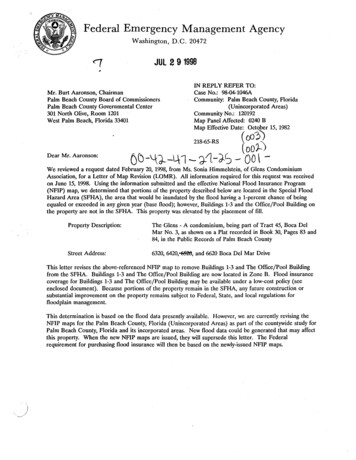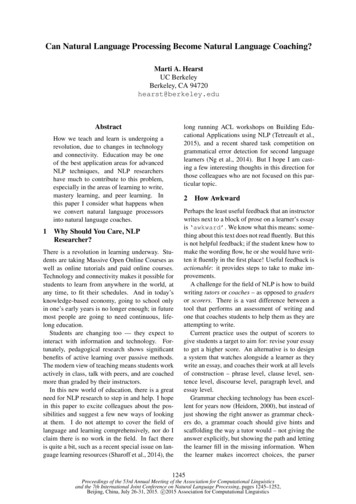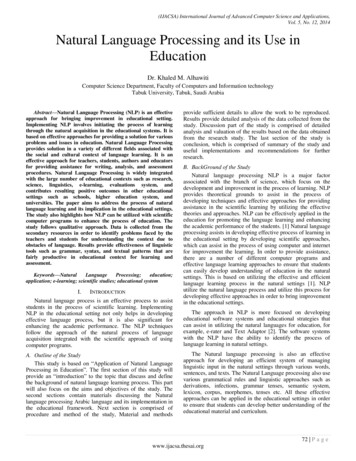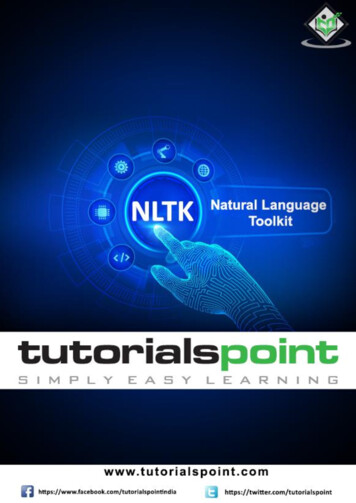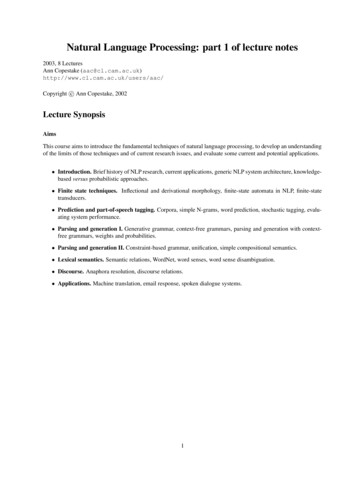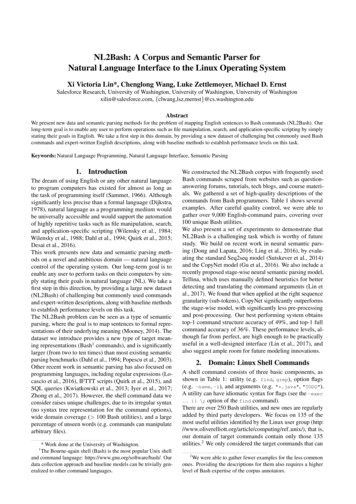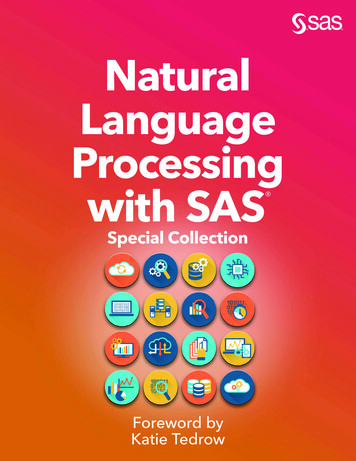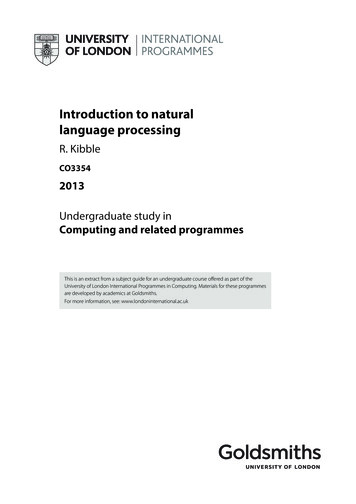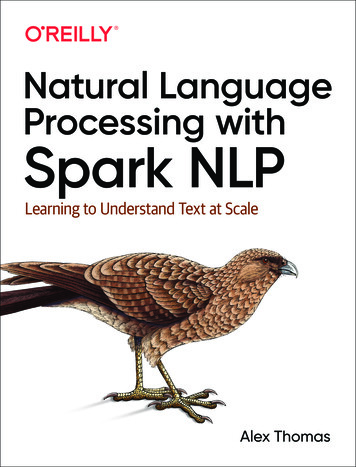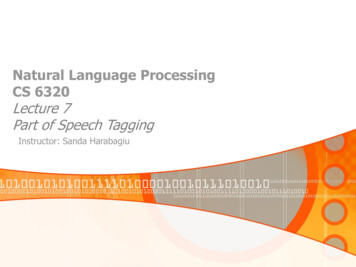
Transcription
Natural Language ProcessingCS 6320Lecture 7Part of Speech TaggingInstructor: Sanda Harabagiu
Today Define Parts of speech (POS) POS Tagsets HMM POS Tagging Viterbi algorithm Maximum Entropy Markov Models Bidirectionality on POS Taggers Conditional Random Fields
What are Parts-of-speech? Parts-of-speech represent the word class, or lexicalcategory of a word, e.g. NOUNS or VERBS orADJECTIVES or DETERMINERS or ADVERBS, etc. Parts-of-speech can be divided into two broad supercategories: closed class types and open class types. Closed classes are those with relatively fixedmembership, such as prepositions—newprepositions are rarely coined. By contrast, nouns and verbs are open classes—new nouns and verbs like iPhone or to fax arecontinually being created or borrowed.
Parts of Speech Four major open classes occur in the languages of the world:nouns, verbs, adjectives, and adverbs. English has all four,although not every language has all of them! NOUNS: The syntactic class noun includes the words for mostpeople, places, or things. Nouns include concrete terms like ship and chair,abstractions like bandwidth and relationship, and verb-liketerms like pacing as in:His pacing to and from became quite annoying. What defines a noun in English, is its ability to:1. occur with determiners (a goat, its bandwidth, Plato’sRepublic),2. to take possessives (IBM’s annual revenue), and3. to occur in the plural form (goats, abaci)
More about NounsOpen class nouns fall into two classes:1. Proper nouns, like Regina, Colorado, and Columbia, are namesof specific persons or entities. In English, they generally aren’t preceded by articles (e.g., “thebook is upstairs”, but “Regina is upstairs”). In written English, proper nouns are usually capitalized.2. Common nouns are divided in two classes:a. count nouns: - allow grammatical enumeration, occurring inboth the singular and plural (goat/goats, relationship/relationships)and they can be counted (one goat, two goats).b. mass nouns: used when something is conceptualized as ahomogeneous group. So words like snow, salt, and communismare not counted (i.e., *two snows or *two communisms).Mass nouns can also appear without articles, where singularcount nouns cannot (“Snow is white” but not“*Goat is white”).
Verbs and Adjectives Verbs refer to actions and processes, including main verbslike draw, provide, and go. English verbs have inflections (non-third-person-sg(eat), third-person-sg (eats), progressive (eating), pastparticiple (eaten)). Adjectives, include many terms for properties or qualities.Most languages have adjectives for the concepts of color(white, black), age (old, young), and value (good, bad), butthere are languages without adjectives.
Adverbs Adverbs are a hodge-podge of words in both form andmeaning. E.g.:Actually, I ran home extremely quickly yesterday Adverbs are modifying something (often verbs, hence thename “adverb”) Directional adverbs or locative adverbs (home, here,downhill) specify the direction or location of some action; Degree adverbs (extremely, very, somewhat) specify theextent of some action, process, or property; Manner adverbs (slowly, slinkily, delicately) describe themanner of some action or process; Temporal adverbs describe the time that some actionor event took place (yesterday).
Closed Classes The closed classes differ more from language to languagethan do the open classes. Some of the important closed classes in English include:
Prepositions Prepositions occur before noun phrases. Semantically, prepositions often indicate spatial ortemporal relations, whether literal (on it, before then, by thehouse) or metaphorical (on time, with gusto, besideherself), but often indicate other relations as well, likemarking the agent in:Hamlet was written by Shakespeare Particles: A particle resembles a preposition or an adverband is used in combination with a verb. Particles often have extended meanings that aren’tquite the same as the prepositions they resemble, as inthe particle over in:she turned the paper over.
Prepositions from CELEX
English Particles
Phrasal Verbs A verb and a particle that act as a single syntacticand/or semantic unit are called a phrasal verb. The meaning of phrasal verbs is often problematicallynon compositional—not predictable from the distinctmeanings of the verb and the particle. Thus: turn down means something like ‘reject’, rule out means ‘eliminate’, find out means ‘discover’, and go on means ‘continue’.
Determiners and Articles A closed class that occurs with nouns, often markingthe beginning of a noun phrase, is the determiner. One small subtype of determiners is the article.English has three articles: a, an, and the.A and an mark a noun phrase as indefinite, while the canmark it as definite; definiteness is a discourse property! Other determiners include this and that (this chapter,that page).
Conjunctions Conjunctions join two phrases, clauses, or sentences. Coordinating conjunctions like and, or, and but jointwo elements of equal status. Subordinating conjunctions are used when one ofthe elements has some embedded status. For example,that in:“I thought that you might like some milk”is a subordinating conjunction that links the main clause “Ithought” with the subordinate clause “you might like somemilk”. This clause is called subordinate because this entireclause is the “content” of the main verb “thought”.Subordinating conjunctions like that which link a verb to itscomplementizer argument in this way are also calledcomplementizers.
Conjunctions
Pronouns Pronouns are words that often act as a kind of shorthandfor referring to some personal noun phrase or entity orevent. Personal pronouns refer to persons or entities (you,possessive she, I, it, me, etc.). Possessive pronouns are forms of personal pronouns thatindicate either actual possession or more often just anabstract relation between the person and some object (my,your, his, her, its, one’s, our, their). Wh-pronouns (what, who, whom, whoever) are used incertain question forms, or may also act as complementizers(Frida, who married Diego. . .)
Auxiliary Verbs Auxiliaries mark semantic features of a main verb: whether an action takes place in the present, past,or future (tense),She was gone all week. whether it is completed (aspect),She has been gone all week. whether it is negated (polarity), andShe hasn’t eaten the bagel. whether an action is necessary, possible, suggested,or copula desired (mood).She would go to school.
Copula and Modals English auxiliaries include the copula verb be, the twoverbs do and modal have, along with their inflected forms,as well as a class of modal verbs. Be is called a copula because it connects subjects withcertain kinds of predicate nominals and adjectives:He is a student. The verb have can mark the perfect tenses: (I have gone, Ihad gone), and be is used as part of the passive (We wererobbed) or progressive (We are leaving) constructions. Modals are used to mark the mood associated with theevent depicted by the main verb: can indicates ability orpossibility, may permission or possibility, must necessity.There is also a modal use of have (e.g., I have to go).
Interjections and NegativesEnglish also has many words of more or less unique function: interjection: (oh, hey, alas, uh, um), negatives (no, not), politeness markers (please, thank you), greetings (hello, goodbye), and the existential there (there are two glasses on the table).
POS Tagging The process of assigning a part-of-speech or lexicalclass marker to each word in a VDETNPDETN
The Task of POS tagging Part-of-speech tagging is the process of assigning a part-ofspeech to each word in part-of-speech tagging a text. Theinput is a sequence x1, x2,., xn of (tokenized) words and atagset, and the output is a sequence y1, y2,., yn of tags,each output yi corresponding exactly to one input xi
POS Tagging-- Choosing a Tagset There are so many parts of speech, potential distinctionswe can draw To do POS tagging, we need to choose a standard set oftags to work with Could pick very coarse tagsets N, V, Adj, Adv. More commonly used set is finer grained, the “PennTreeBank tagset”, 45 tags PRP , WRB, WP , VBG Even more fine-grained tagsets exist
Penn TreeBank POS Tagset
Universal Dependency Tagset
Using the Penn TagsetEXAMPLE ANNOTATIONS:
Corpora labeled with POS tags Corpora labeled with parts-of-speech are crucial training(and testing) sets for statistical tagging algorithms. Three main tagged corpora are consistently used fortraining and testing part-of-speech taggers for English:1. The Brown corpus is a million words of samples from500 written texts from different genres published in theWSJ United States in 1961.2. The WSJ corpus contains a million words published inthe Switchboard Wall Street Journal in 1989.3. The Switchboard corpus consists of 2 million words oftelephone conversations collected in 1990-1991.The corpora were created by running an automatic part-ofspeech tagger on the texts and then human annotatorshand-corrected each tag.
POS Tagging Part-of-speech tagging is the process of assigning a partof-speech marker to each word in an input text.The input to a tagging algorithm is (1) a sequence of(tokenized) words and (2) a tagset, and the output is asequence of tags, one per token.BUT: lexical ambiguity!!!!!!!!!!!!!!!!!!! Words often have more than one POS: back The back door JJ On my back NN Win the voters back RB Promised to back the bill VB The POS tagging problem is to determine the POS tag fora particular instance of context for a word.
Lexical ambiguity POS Tagging is a disambiguation task because wordsare ambiguous —have more than one possible part-ofspeech—and the goal is to find the correct tag for thecontext in which the word appears! How bad is the ambiguity?
How Hard is POS Tagging? Measuring Ambiguity POS Tagging is a disambiguation task because wordsare ambiguous —have more than one possible part-ofspeech—and the goal is to find the correct tag for thecontext in which the word appears! Some of the most ambiguous frequent words are:that, back, down, put and set;
Example: the lexical ambiguity of “back” The word “back” may be tagged with 6 different partsof-speech:
Rule-Based Tagging: Some good news!!! Many words are easy to disambiguate, because theirdifferent tags aren’t equally likely. a simplistic baseline algorithm for part-of-speechtagging: given an ambiguous word, choose the tagwhich is most frequent in the training corpus. This is a key concept:How good is this baseline? A standard way to measurethe performance of part-of-speech taggers is accuracy:the percentage of tags correctly labeled (matching humanlabels on a test set)
Starting point If we train on the WSJ training corpus and test onsections 22-24 of the same corpus the most-frequenttag baseline achieves an accuracy of 92.34%. The state of the art in part-of-speech tagging on thisdataset is around 97% tag accuracy, a performancethat is achievable by most algorithms (HMMs, MEMMs,neural networks, rule-based algorithms)
Hidden Markov Model for POS Tagging The Hidden Markov Model is a probabilistic sequencemodel: given a sequence of units (words, sentences,whatever), it computes a probability distribution overpossible sequences of labels and chooses the bestlabel sequence. The HMM is based on augmenting the Markov chain.
Definitions A weighted finite-state automaton addsprobabilities to the arcs The sum of the probabilities leaving any arc mustsum to one A Markov chain is a special case of a WFST inwhich the input sequence uniquely determineswhich states the automaton will go through Markov chains can’t represent inherentlyambiguous problems Useful for assigning probabilities to unambiguoussequences
Formalizing Hidden Markov Model taggers HMM is an extension of finite automata A FSA is defined by a set of states a set of transitionsbetween states that are taken based on observations. A weighted finite-state automaton is an augmentationof the FSA in which the arcs are associated with aprobability – indicating how likely that path is to betaken.baaq0q2q1abbq3abq4b0.5aq7b bq6q5 a baFSAInput: aabaq9aabq80.3q0q20.2q1bba0.50.7q3ab0.4q40.6A Markov Chain special WFSA0.8q90.9aq7bb0.1 a0.70.8bq60.60.3bq5 a 0.2 q8a0.4WFSAInput: aabThe input sequenceDetermines whichStates the WFSA wilGo through.
Markov Chains A Markov chain is a model that tells us something aboutthe probabilities of sequences of random variables,(which represent the states), each of which can take onvalues from some value set. The value sets can be words, or tags, or symbolsrepresenting anything. For example the weather. A Markov chain makes a very strong assumption that ifwe want to predict the future in the sequence, all thatmatters is the current state. All the states before thecurrent state have no impact on the future except viathe current state. It’s as if to predict tomorrow’s weatheryou could examine today’s weather but you weren’tallowed to look at yesterday’s weather.
Markov Chain for WeatherA start distribution π is required; setting π [0.1, 0.7, 0.2]
Markov Chain for Weather What is the probability of 4 consecutive rainy days?Sequence is rainy-rainy-rainy-rainyI.e., state sequence is 3-3-3-3P(3,3,3,3) 3a33a33a33a33 0.2 x (0.6)3 0.0432State 1State 2State 30.50.30.2State 1State 2State 3 State 4State 00.50.30.2State 10.60.10.20.1State 20.20.40.30.1State 30.10.20.60.1A
Markov Chain for WordsA bigram language model !!!
Markov Chain: “First-order observable Markov Model” Consider a sequence of state variables q1,q2 qN; A Markov model embodies the Markov assumption on theprobabilities of this sequence: that Markov assumptionwhen predicting the future, the past doesn’t matter, onlythe present. Current state only depends on previous stateP(qi q1.qi 1) P(qi qi 1)Markov Assumption
Markov Chain Definition A Markov chain is specified by :
Back to the Hidden Markov Model A Markov chain is useful when we need to compute aprobability for a sequence of observable events. In manycases, however, the events we are interested in are hidden: we don’t observe them directly. For example we don’t normally observe part-of-speechtags in a text. Rather, we see words, and must infer thetags from the word sequence. We call the tags hiddenbecause they are not observed! A hidden Markov model (HMM) allows us to talk aboutboth observed events (like words that we see in the input)and hidden events (like part-of-speech tags) that we thinkof as causal factors in a probabilistic model.
Definition of HMM It has five components:
Important Assumptions A first-order hidden Markov model instantiates two simplifyingassumptions.First, as with a first-order Markov chain, the probability of aparticular state depends only on the previous state:Second, the probability of an output observation oi depends onlyon the state that produced the observation qi and not on any otherstates or any other observations:
The components of an HMM tagger-1 An HMM has two components, the A and B probabilities The A matrix contains the tag transition probabilities:P(ti ti 1) which represent the probability of a tag occurringgiven the previous tag.For example, modal verbs like “will” are very likely to befollowed by a verb in the base form, a VB, like “race”, so weexpect this probability to be high. We compute the maximumlikelihood estimate of this transition probability by counting,out of the times we see the first tag in a labeled corpus, howoften the first tag is followed by the second:
Examples In the WSJ corpus, for example, the MD tag occurs13124 times of which it is followed by the VB tag 10471,giving for an MLE estimate of:
The components of an HMM tagger-2 The B emission probabilities, P(wi ti), represent theprobability, given a tag (say MD), that it will be associatedwith a given word (say will). The MLE of the emission probability is: Example: Of the 13124 occurrences of MD in the WSJcorpus, it is associated with will 4046 times:
HMM for POS Tagging A different view of HMMs, focused on the A transition probabilitiesused to compute the prior probability and the word likelihoods B.
HMM tagging as decoding For any model, such as an HMM, that contains hiddenvariables, the task of determining the hidden variablessequence corresponding to the sequence of observations iscalled decoding.
HMM decoding for POS tagging For part-of-speech tagging, the goal of HMM decoding is tochoose the tag sequence t1 .tn that is most probable given theobservation sequence of n words w1 .wn:tˆ1n arg max P(t1n w1n )t1nThe way we’ll do this in the HMM is to use Bayes’ rule to insteadcompute:Drop the denominator:
Some more assumptions HMM taggers make two further simplifying assumptions.Assumption 1: the probability of a word appearing depends onlyon its own tag and is independent of neighboring words and tags:nn nP( w1 t1 ) P( wi ti )i 1Assumption 2: the bigram assumption: the probability of a tag isdependent only on the previous tag, rather than the entire tagsequence:nP(t1n ) P(ti ti 1 )i 1
The Viterbi Algorithm for HMMs 1/6 The most common decoding algorithm for HMMs is theViterbi algorithm. THE VITERBI ALGORITHM INPUT: (1) a single HMM and (2) a set of observed words o (o1, o2, ot) OUTPUT: (1) the most probable state/tag sequence q (q1, q2 qt)together with (2) its probability.The Viterbi algorithm first sets up a probability matrix or lattice, with onecolumn for each observation (word) and one row for each state (possiblePOS tag) in the state graph.
Example of lattice the lattice for Janet will back the bill, showing thepossible tags (qi) for each word :
The Viterbi Algorithm
How does it work? Each cell of the latice, vt(j), represents the probability thatthe HMM is in state j after seeing the first t observations andpassing through the most probable state sequenceq1,.,qt 1, given the HMM λ. We compute vt(j) by recursively taking the most probablepath that could lead us to this cell: Given that we had already computed the probability of beingin every state at time t 1, we compute the Viterbi probabilityby taking the most probable of the extensions of the pathsthat lead to the current cell:
Important The three factors that are multiplied:
Walking through an example Let us tag:Janet will back the billTo define the HMM, we need the values of the matrix A:TransitionprobabilitiesAs well as the values of matrix B:Observationlikelihoods
Example of lattice v1(NNP) 0.2767 0.000032 INITIALIZATION STEP For t 2: we compute v2(MD), v2(VB), and v2(NN) andchose the maximum
2nd example for the Viterbi Algorithm How it works? It builds a probability matrix:The Viterbi value 4NN0.41 1.0 0 0.0045 0.25 000054.0012 .000051 0 03TO0.042 1.0 0 0.00079 .25 0 0.83 .000051 .992VB0.019 1.0 0 00.23 0.25 0.093 .000051.0038 .000051 0 01PPSS0.067 1.0 0.37 0.25.00014 .25 0 0.007 .000051 0 00start#Iwanttorace#012345exerciseendexercise5The product of:1. The transition probabilityA[I,j]2. Previous path probabilityViterbi[s’,t-1]3. Observation likelihoodBs[ot]1.0One row for each stateTag Transition Probabilities (Brown corpus)One column for each observationObservations likelihoods (Brown corpus)
Viterbi Summary Create a matrix With columns corresponding to inputs Rows corresponding to possible states Sweep through the array in one pass filling the columnsleft to right using our transition probabilities andobservations probabilities Dynamic programming key is that we need only storethe MAX probability path to each cell, (not all paths).
Extending HMMs to trigrams 1/2 Previous assumption: the tag appearing is dependent only on the previoustag:nnP(t1 ) P(ti ti 1 )i 1 Most modern HMM taggers use a little more history – the previous 2 tagsnnP(t1 ) P(ti ti 1 , ti 2 )i 1 o let the tagger know the location of the end of the sentence by addingdependence on an end-of-sequence marker for tn 1. POS tagging is doneby: n nnnˆt1 arg max P(t1 w1 ) arg max P( wi ti ) P(ti ti 1 , ti 2 ) P(t n 1 t n ) i 1 t1nt1nOne problem: data sparsity
Deleted interpolation 1/2 Compute the trigram probability with MLE from counts:C (ti 2 , ti 1 , ti )P (ti ti 1 , ti 2 ) :C (ti 2 , ti 1 )Many of these counts will be 0! Solution: estimate the probability by combining more robust but weakerestimators. E.g if we never seen PRP VB TO, we cannot compute P(TO PRP,VB) but we can compute P(TO VB) or even P(TO).C (ti 2 , ti 1 , ti )Trigrams Pˆ (ti ti 1 , ti 2 ) C (ti 2 , ti 1 )C (ti 1 , ti )ˆBigrams P (ti ti 1 ) C (ti 1 )C (ti )Unigrams Pˆ (ti ) NMaximum Likelihood EstimationHow should they be combined?P(ti ti 1ti 2 ) 3 Pˆ (ti ti 1ti 2 ) 2 Pˆ (ti ti 1 ) 1Pˆ (ti )63
Deleted Interpolation 2/2
Beam Search When the number of states grows very large, the vanillaViterbi algorithm will be slow! The complexity of thealgorithm is O(N2T); N (the number of states) can be largefor trigram taggers, which have to consider every previouspair of the 45 tags, resulting in 453 91,125 computationsper column. N can be even larger for other applications ofViterbi, for example to decoding in neural networks. Solution: Beam SearchIn beam search, instead of keeping the entire column ofstates at each time point t, we just keep the best fewhypothesis at that point.
Beam Width One way to implement beam search is to keep a fixed number ofstates instead of all N current states. Here the beam width β is afixed number of states. Alternatively β can be modeled as a fixedpercentage of the N states, or as a probability threshold.Example: β 2At each time t, all (non-zero) states are computed, but then they aresorted and only the best 2 states are propagated forward and the restare pruned, shown in orange.
Maximum Entropy Markov Models Good News: an HMM can achieve very high accuracy! Bad News: it requires a number of architecturalinnovations to deal with: unknown words, backoff,suffixes, and so on. What we would like: easy way to add arbitrary features directly intothe model, but that’s hard for generative models like HMMs! Logistic regression could be a solution, but:1. it isn’t a sequence model;2. it assigns a class to a single observation. What can we do? Turn logistic regression into adiscriminative sequence model simply by running it onsuccessive words, using the class assigned to the priorword as a feature in the classification of the nextword. This is the Maximum Entropy Markov Modelor MEMM
Difference HMM - MEMMIn an HMM to compute the besttag sequence that maximizesP(T W) we rely on Bayes’ rule andthe likelihood P(W T):In an MEMM, we compute theposterior P(T W) directly, training itto discriminate among the possibletag sequences:
Features of an MEMMNote: we don’t build MEMMs that condition just on wi and ti 1.The reason to use a discriminative sequence model is that it’seasier to incorporate a lots of features!A basic MEMM part-of-speech tagger conditions on the observation worditself, neighboring words, and previous tags, and various combinations,using feature templates like the following:AbstractRepresentationOf features
Feature Templates feature templates are used to automatically populate theset of features from every instance in the training and testset. Our example:Janet/NNP will/MD back/VB the/DT bill/NN,-when wi “back”, we generate the following features:
More features: Word Shape Word shape features are used to represent the abstractletter pattern of the word How? Map lower-case letters to ‘x’, Map upper-case to ‘X’, Map numbers to ’d’, retaining punctuation. T Examples:o I.M.F. would map to X.X.X.o DC10-30 would map to XXdd-dd.o UTD maps into XXX
Second class of word features A second class of shorter word shape features is also used. How? In these features consecutive character types areremoved! Example: DC10-30 (already mapped into XXdd-dd ) wouldbe mapped to Xd-d but I.M.F would still map to X.X.X. the word well-dressed would generate the following nonzero valued feature values:
Decoding and Training MEMMsfeaturesfeatures
Option 1: Greedy Decoding Build a local classifier that decides the POS tag for each word left toright, making a hard classification of the first word in the sentence, thena hard decision on the second word, and so on. This is called a greedydecoding algorithm, because we greedily choose the best tag for eachword!Features, θ The problem with the greedy algorithm is that by making a hard decisionon each word before moving on to the next word, the classifier can’t useevidence from future decisions. Although the greedy algorithm is veryfast, and occasionally has sufficient accuracy to be useful, in general thehard decision causes too much a drop in performance, and we don’t useit.
Decode an MEMM with the Viterbi algorithm What do we need to change?
More details How?In the recursive step: the Viterbi equation computes the Viterbi value of time t forstate j as:which is the HMM implementation of: The MEMM requires only a slight change to this latter formula,replacing the A and B prior and likelihood probabilities with thedirect posterior:
Learning in MEMMs Learning in MEMMs relies on the supervised learningalgorithms. E.g. logistic regression. Given:o a sequence of observations, fo feature functions, ando corresponding hidden states use gradient descent to train the weights tomaximize the log-likelihood of the training corpus.
Bi-directionalityProblem: the MEMM and HMM models exclusively run leftto-right. While the Viterbi algorithm still allows present decisions tobe influenced indirectly by future decisions, it would helpeven more if a decision about word wi could directly useinformation about future tags ti 1 and ti 2. One way to implement bidirectionality is to switch to a morepowerful model called a conditional random field or CRF. What are CRFs?
From HHMs to MEMM to CRF -1 HMMS Generative Models Find parameters to maximize P(X,Y) Assumes features are independent ! When labeling Xi future observations are taken intoaccount (forward-backward)
From HHMs to MEMM to CRF -2 MEMM Discriminative Find parameters to maximize P(Y X) No longer assume that features are independent ! Do not take future observations into account
From HHMs to MEMM to CRF -3 CRF Discriminative Doesn’t assume that features are independent When labeling Yi future observations are taken into account The best of both .umass.edu/ mccallum/papers/crf-tutorial.pdf
CRFs for a word sequence x (x1, . . . , x x ) and a POSsequence y (y1, . . . , y x ) is defined as:weights where n denotes the model order, w the model parametervector, and φ the feature extraction function. at each time step the CRF computes log-linear functionsover a clique, a set of relevant features.More details: http://www.aclweb.org/anthology/P14-2043 CRF implementations:
Difference HMM - CRFsIn an HMM to compute the besttag sequence that maximizesP(T W) we rely on Bayes’ rule andthe likelihood P(W T):In a CRF, we compute the posteriorP(T W) directly, training it todiscriminate among the possible tagsequences:However, the CRF does not computea probability for each tag at eachtime step. Instead, at each time stepthe CRF computes log-linearfunctions over a set of relevantfeatures, and these local features areaggregated and normalized toproduce a global probability for thewhole sequence
Conditional Random Fields In a CRF, the function F maps an entire input sequence X andan entire output sequence Y to a feature vector. Let’s assumewe have K features, with a weight wk for each feature Fk :These K functions Fk(X,Y) are global features, since each one isa property of the entire input sequence X and output sequence Y.We compute them by decomposing into a sum of local features foreach position i in Y:
Linear Chain CRF Each of these local features fk in a linear-chain CRF is allowedto make use of the current output token yi , the previous outputtoken yi 1, the entire input string X (or any subpart of it), and thecurrent position i. This constraint to only depend on the currentand previous output tokens yi and yi 1 are what characterizes alinear chain CRF
Features in a CRF POS Tagger in a linear-chain CRF, each local feature fk at position i candepend on any information from: (yi 1, yi ,X,i).Example of features representing common situations might be:Let us assume all CRF features take on the value 1 or 0. Above,we explicitly use the notation 1{x} to mean “1 if x is true, and 0otherwise”.Use feature templates and word shape features!!!
Inference and Training of CRFs
Invitation: Go and play!!! Stanford POS gger.shtmlIt has a version for twitter as wellEnglish and multi-lingual
Summary Introduced parts-of-speech and part-of-speech tagging: Two common approaches to sequence modeling are a generativeapproach, HMM tagging, and a discriminative approach, MEMM tagging. The probabilities in HMM taggers are estimated by maximum likelihoodestimation on tag-labeled training corpora. The Viterbi algorithm is used fordecoding, finding the most likely tag sequence. Beam search is a variant of Viterbi decoding that maintains only a fractionof high scoring states rather than all states during decoding.
Verbs and Adjectives Verbs refer to actions and processes, including main verbs like draw, provide, and go. English verbs have inflections (non-third-person-sg (eat), third-person-sg (eats), progressive (eating), past participle (eaten)). Adjectives, include many terms for properties or qualities. Most languages have adjectives for the concepts of color
